Boiling technique is everywhere in cooking—from the bubbling pot of pasta on a Sunday night, to the hearty, comforting stew simmering away on a winter afternoon. It’s a method so familiar, so basic, that we rarely stop to appreciate its role in the culinary world. But here’s the thing—boiling technique isn’t just throwing ingredients into hot water. There’s an art to it, a science, and a world of possibilities.
Whether you’re trying to cook a perfect al dente pasta, enhance the flavors of a broth, or simply not end up with mushy vegetables, this guide will help you master boiling like a pro.
What Is Boiling Technique and Why Does It Matter?
At its core, boiling technique is the process of heating water to its boiling point—212°F (100°C) at sea level. You’ll recognize the rapid, rolling bubbles as water gets agitated by the high heat. Food is submerged, cooked through this heat transfer, and transformed.
But not all boiling is the same. It’s important to differentiate boiling from other moist-heat techniques like poaching or simmering. Boiling technique is aggressive—ideal for pasta or hard vegetables—whereas poaching or simmering use gentler heat for delicate proteins like eggs or fish. Knowing this distinction is essential for tailoring your cooking to your dish’s needs.
A Brief History of Boiling Technique
Believe it or not, boiling technique predates modern cookware by thousands of years. Ancient civilizations used hot stones in water-filled pits or clay vessels to prepare meals. Why? Because boiling unlocked nutrients and flavors, even with meager ingredients.
From Chinese wonton soup to French pot-au-feu, boiling has played a starring role in iconic dishes across cultures. It’s a universal technique—one that not only cooks food but also brings communities together.
The Benefits of Boiling Technique
Why is boiling technique still one of the most relied-on cooking methods? Because it’s simple, adaptable, and delivers numerous advantages.
1. Nutritional Wins
Boiling helps retain nutrients when compared to methods like frying, especially in dishes where the cooking liquid (think soups and broths) is consumed.
2. Economical and Sustainable
No fancy equipment or expensive oils are needed—just water and heat. Plus, it’s energy-efficient, and leftover water can often be reused for other dishes or even your plants.
3. Safety First
Boiling kills harmful bacteria, making water safe to drink or raw ingredients safe to consume.
4. Versatility
From weeknight pasta to an elaborate ramen broth, boiling adapts to your needs.
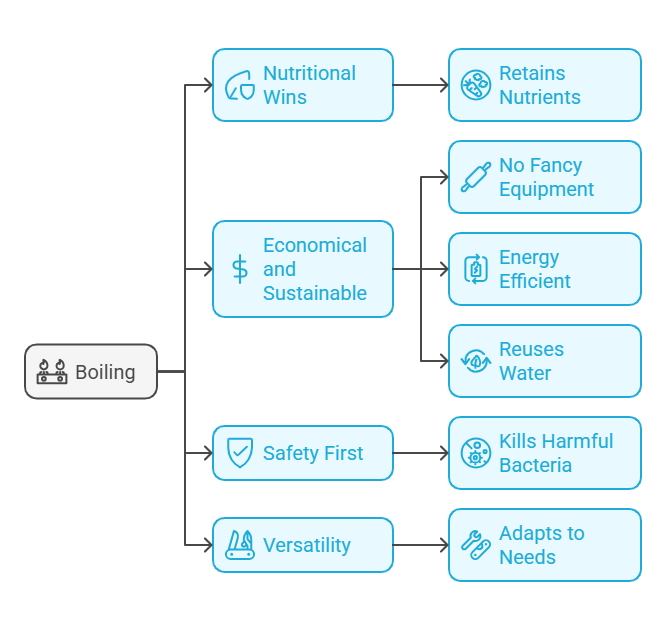
The Science of Boiling Technique
To master boiling, you need to understand the science behind it. The boiling point of water is a constant 212°F (100°C) at sea level, but this changes with altitude. At higher altitudes, water boils at a lower temperature because reduced air pressure requires less energy to turn water to steam.
This means that cooking times may increase in mountainous areas, where water reaches a boil before reaching its full heating potential.
Another piece of the puzzle? Water’s temperature stability. Unlike frying, boiling water maintains a consistent cooking temperature, which ensures even, predictable results.
Boiling Techniques and Types
Not all boils are equal. Different ingredients and dishes call for different types of boiling.
Full Boil
A vigorous, rolling boil is best for pasta, grains, and hard vegetables. It ensures quick, even cooking.
Gentle Boil
Close to a simmer, gentle boiling is ideal for eggs, seafood, and tender dumplings, where too much movement could damage the ingredients.
Step-by-Step Guide to Perfect Boiling
- Pot Selection: Choose a pot large enough for your ingredients to move freely.
- Water Quantity: Use enough water to fully submerge the food. For pasta, aim for at least 4 quarts per pound.
- Heat It Up: Bring the water to the desired boil before adding ingredients.
- Season the Water: For pasta and vegetables, salting the water enhances flavor. Think seawater levels! (And no, oiling the water isn’t necessary.)
- Timing is Everything: Check cooking times for each ingredient. Overcooking leads to mushy textures and lost nutrients.
- Drain Efficiently: Use a colander or strainer for precise draining.
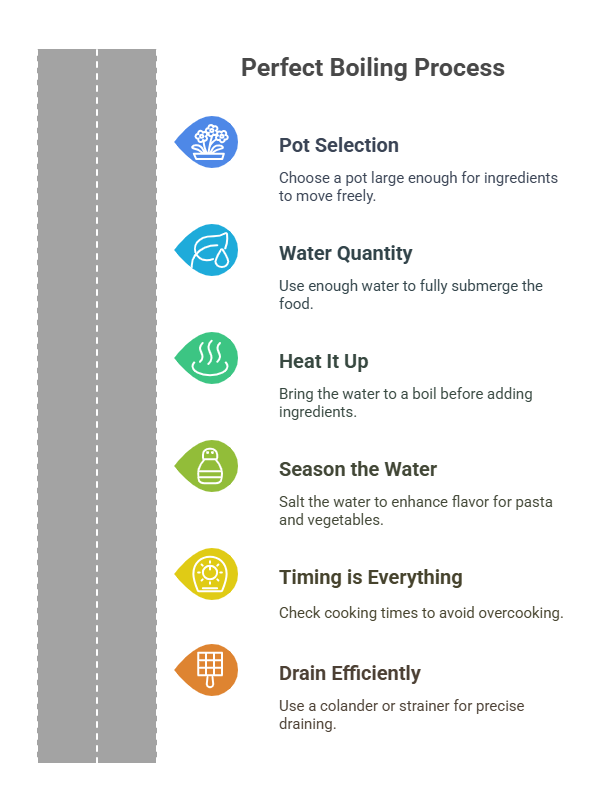
Best Ingredients for Boiling Technique
Some ingredients shine when boiled.
- Vegetables
Boiling helps tenderize and preserve vibrant colors when done right. To keep veggies crisp and green, shock them in ice water after boiling.
- Pasta and Grains
Pasta requires a roaring boil for that perfect al dente bite, while grains like quinoa benefit from a measured simmer to prevent sticking.
- Proteins
From beautifully soft-boiled eggs to poached chicken, the key to protein boiling is temperature control.
- Soups and Broths
Long, slow boiling extracts maximum flavor from bones and vegetables, creating rich, hearty bases.
Common Mistakes to Avoid
Even the simplest methods can go wrong. Avoid these common boiling pitfalls:
- Overboiling leads to loss of texture and nutrients.
- Crowding the Pot lowers the water temperature, slowing cooking.
- Skipping Seasoning results in bland ingredients. Salt enhances flavors directly during the cooking process.
- Improper Timing leaves some ingredients overcooked while others remain underdone.
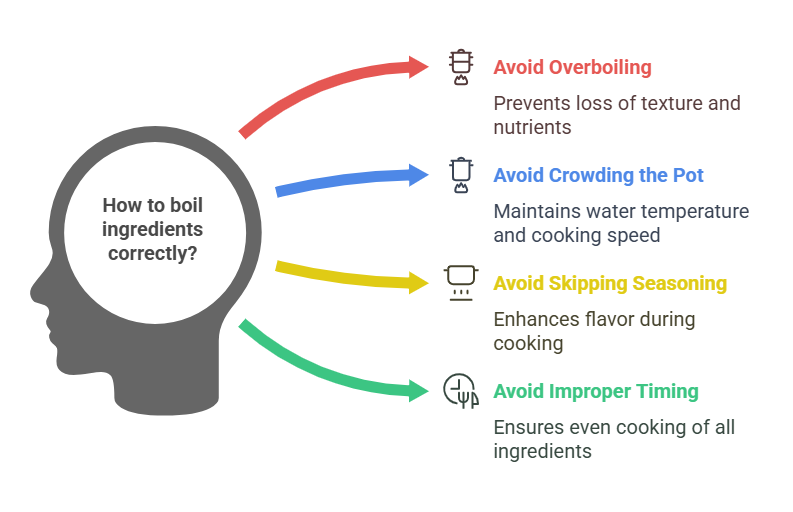
Boiling Technique vs. Other Methods
How does boiling compare to steaming, poaching, or frying?
- Health Benefits
Compared to frying, boiling requires no additional fats, making it healthier. Boiling also preserves dietary fibers often destroyed during steaming or grilling.
- Texture Differences
Roasted chicken has a crispy skin, while boiled chicken remains tender but lacks browning. Each method has its strengths depending on your dish’s goals.
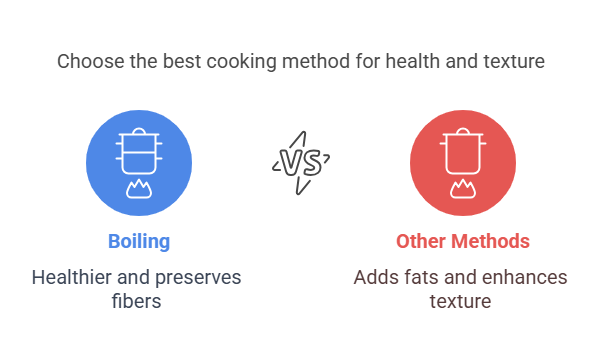
Recipes Highlighting the Boiling Technique
How do real recipes hero boiling?
1. Perfectly Boiled Eggs
Soft, medium, or hard—you decide. Boil eggs for 6-12 minutes, then plunge them into an ice bath to stop cooking immediately.
2. Al Dente Pasta
Boil pasta for the time recommended on the package minus 1 minute. Finish in the sauce for full absorption of flavor.
3. Vietnamese Pho
A broth-based dish where hours of boiling yield a fragrant, comforting meal.
4. Boiled Vegetable Medley
Pair colorful, tender-crisp veggies with olive oil and herbs for an effortless side.
Advanced Boiling Techniques
Blanching and Shocking
Quickly boil vegetables, then chill in an ice bath. This technique locks in color and texture, perfect for salads.
Parboiling for Preparation
Short boiling—before grilling or frying—ensures ingredients like potatoes or ribs are cooked evenly.
Double Boiling for Delicate Results
Used for custards or delicate sauces, this technique harnesses steam’s gentle heat to cook indirectly.
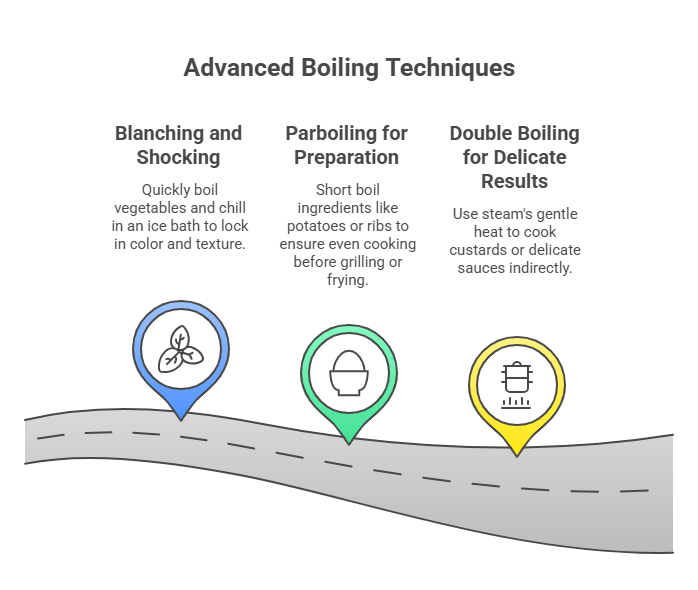
Sustainability Tips
Boiling is inherently sustainable, but you can take it further by reusing cooking water (loaded with nutrients) for soups or sauces or even for watering plants.
Pro Tips for Expert Boiling
- Add herbs, garlic, or spices to boiling water for extra flavor infusion.
- Layer ingredients with different densities—start with harder items like potatoes, then finish lighter ones like green beans.
- Always use a timer—guesswork leads to uneven results.
Closing Thoughts
Boiling technique is more than just a basic cooking method—it’s a gateway to culinary mastery. By perfecting the technique, you’ll not only elevate the simplest recipes but also expand your range as a home chef.
Experiment, try the recipes linked here, and discover why boiling remains one of the most essential and versatile tools in your kitchen arsenal!
📌 Stay connected with us!
- Follow us on Instagram: @RoastedKitchen25 for daily cooking inspiration.
- Tag us in your creations using #RoastedKitchenboiling—we’d love to see what you make!
Subscribe to our newsletter for exclusive recipes, expert tips, and kitchen hacks straight to your inbox!
FAQ
- What is the difference between boiling, poaching, and simmering?
Boiling involves cooking food at a high temperature of 212°F (100°C) at sea level, with rapid, rolling bubbles. It’s ideal for hardy ingredients like pasta or potatoes. Simmering is gentler, keeping water just below boiling with small bubbles, perfect for delicate dishes like soups or braises. Poaching is even milder, cooking at 160-180°F (71-82°C), ideal for delicate proteins like fish or eggs. - How does altitude affect boiling?
At higher altitudes, air pressure decreases, which lowers the boiling point of water. For instance, water may boil at around 200°F (93°C) or lower in mountainous regions, meaning food takes longer to cook since the water isn’t as hot. Adjusting cooking times is essential in such conditions. - What are the best ingredients to boil?
Some great ingredients for boiling include:
- Vegetables: Carrots, green beans, or potatoes for tender and flavorful results.
- Pasta and Grains: For perfectly cooked pasta or fluffy grains like quinoa.
- Proteins: Eggs, chicken, and seafood, which maintain tenderness with controlled boiling.
- Soups and Broths: Long boiling extracts flavors from bones and veggies for rich, hearty bases.
- Why add salt to water when boiling?
Salt increases the water’s boiling point slightly, but more importantly, it enhances the flavor of the food as it cooks. For pasta or vegetables, properly salted water ensures your food doesn’t taste bland. - How can I avoid overcooking when boiling?
- Use a timer to track cooking times for each ingredient.
- Start with cold water for items like eggs or potatoes and bring it to a boil gradually for even cooking.
- Remove food immediately once done and shock vegetables in ice water to stop the cooking process.
- Why does pasta water foam, and how do I handle it?
Pasta releases starch as it cooks, creating foam. To manage it, don’t overcrowd your pot, and keep an eye on the heat level to prevent boiling over. Stir occasionally to avoid sticking and bubbling foam. - Can I reuse boiling water?
Yes! Reuse leftover boiling water as a base for soups or sauces. If you’ve boiled vegetables, the water is infused with nutrients and adds depth to broths. You can also cool it and use it for watering plants. - What are the common mistakes to avoid when boiling?
- Overboiling: Leads to mushy textures and nutrient loss.
- Crowding the pot: Slows cooking and results in uneven temperatures.
- Skipping seasoning: Leads to bland-tasting food. Always salt the water!
- Improper timing: Different ingredients have unique cooking times, so plan ahead.
- Is boiling healthier than frying or roasting?
Yes, boiling doesn’t require additional fats or oils, making it a low-calorie cooking method. It also helps retain dietary fibers and water-soluble vitamins, especially if you consume the cooking liquid (as in stews or soups). Unlike frying, boiling doesn’t introduce harmful compounds from high heat. - Can I boil food too long? What happens?
Yes, overboiling can lead to mushy vegetables, tough proteins, or overly soft pasta. Nutrients may also leach out into the water, reducing the food’s nutritional value if the cooking liquid isn’t consumed. - Why do chefs shock vegetables after boiling?
Shocking vegetables in ice water after boiling stops the cooking process immediately, locking in vibrant color, texture, and nutrients. This is especially useful for dishes like salads or veggie platters. - Does boiling change food texture?
Yes, boiling softens ingredients and tenderizes fibers. For some items, like eggs or pasta, it creates a perfect, tender texture. However, for proteins like chicken, it won’t achieve the crispness you might get with roasting or frying—boiling keeps things moist and tender instead. - What’s the best way to boil different components together?
Layer ingredients based on their cooking times. Start by boiling denser, longer-cooking items like potatoes, then add quicker-cooking ingredients—like green beans—toward the end. This ensures each element is perfectly cooked. - Does adding oil to boiling water help?
No, adding oil doesn’t prevent sticking and can create an oily layer on the food. Instead, stir ingredients regularly (especially pasta) and use enough water for them to move freely. - Are there any advanced boiling techniques I can try?
Certainly!
- Blanching and Shocking: For vibrant, crisp vegetables ideal for salads or side dishes.
- Parboiling: Prepares items like potatoes or ribs to ensure even cooking during frying or roasting.
- Double Boiling: Uses gentle, indirect heat for delicate sauces, custards, or herbal soups.
This FAQ equips you with everything you need to elevate your boiling skills and get consistently excellent results in the kitchen!

Hi, I’m Mayaz Ahsan!
As a passionate cook, storyteller, and food enthusiast, I combine my love for travel, farming, reading, and teaching to bring you insightful culinary tips and stories. Welcome to Roasted Kitchen – I’m thrilled to share this journey with you!

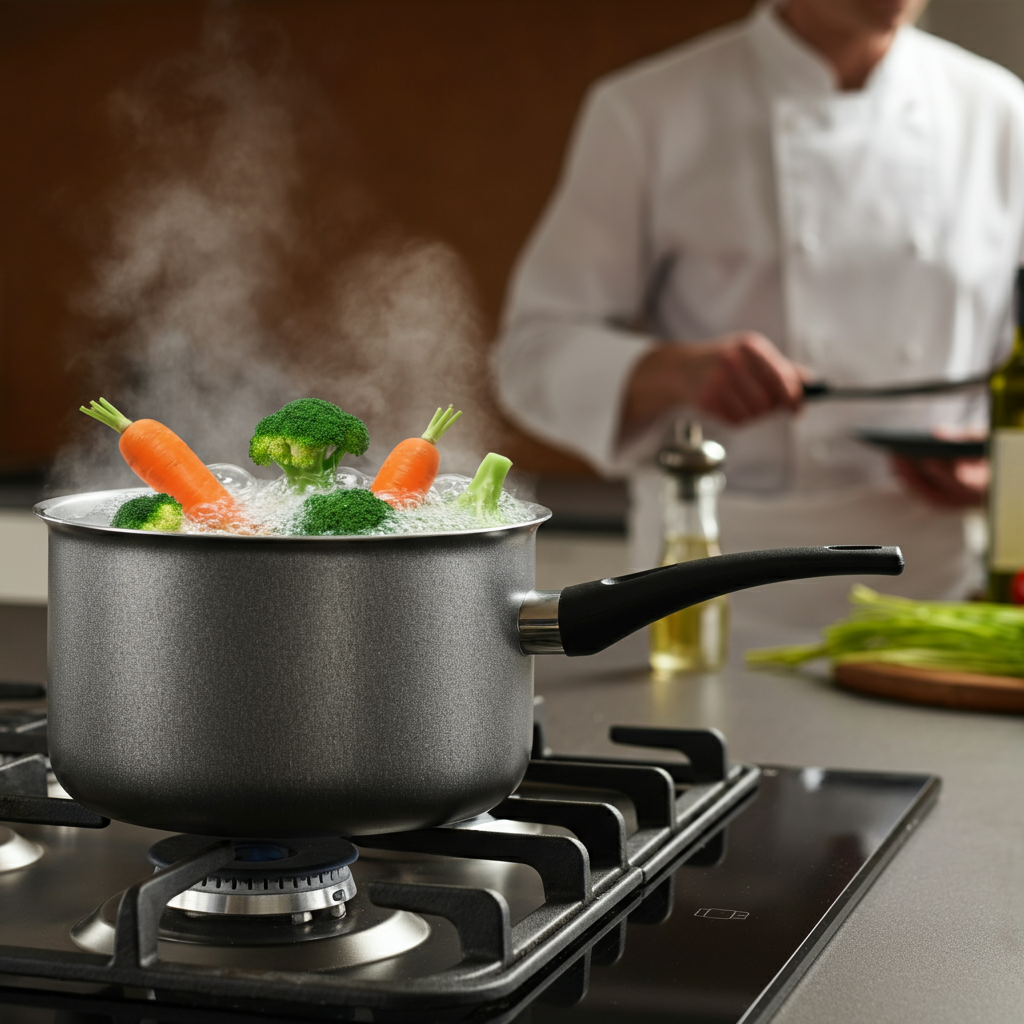








 Subscribe to our free newsletter for tips, tutorials, and insights!
Subscribe to our free newsletter for tips, tutorials, and insights!